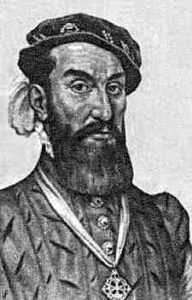A Spanish explorer and the first historian of Texas, Alvar Nunez Cabeza de Vaca sailed to North America from Spain in an expedition led by Panfilo de Narvaez in 1527. He and a group of some 300 men survived a hurricane near Cuba to land on the west coast of Florida, near present-day Tampa Bay, in April 1528, claiming the land for Spain. Hearing from the natives that there was gold to the north, Narváez split up his men, and he and his followers began an overland expedition in May. However, the expedition was met with a series of hurricanes and violent conflicts with Native Americans, resulting in the deaths of many of the men. The difficult and distressing march northward finally landed the remaining men near present-day St. Marks, Florida, near the end of July.
In the meantime, the ship captain and the remaining men sailed to Mexico. Some 245 stranded men hastily made five make-shift rafts on which they sailed west, hoping to reach a Spanish settlement in Mexico. The rafts drifted along the northern part of the Gulf of Mexico, passing Pensacola Bay and the mouth of the Mississippi River.
Along the way, three rafts sank, including the one that Narváez was riding upon, when it was suddenly blown out to sea in November 1528. The two remaining rafts continued, finally landing on Galveston Island, Texas. After a frigid winter with very little food, only 15 men survived. In the spring, the men traveled west by land, walking along the Colorado River. By 1533, there were only four survivors, including Cabeza de Vaca. The men were enslaved by some Indian tribes along the way and helped by others. They were the first non-natives to travel to this area of southwestern North America and the first Europeans to see the bison or American buffalo. During this time, he became a trader and shaman to various Native American tribes.
The four men finally reached Culiacan’s Spanish settlement in early 1536 (eight years after being stranded in Florida). Later that year, they reached Mexico City, where the Viceroy Antonio de Mendoza welcomed them.
After returning to Spain in 1537, Cabeza de Vaca wrote an account, first published in 1542, as La Relación (The Relation), which was re-titled Shipwrecks in later editions. In 1540, Cabeza de Vaca was appointed Adelantado, a Spanish Noble of then present-day Argentina, where he was governor and captain-general of Río de la Plata (now called Paraguay). He explored the Paraguay River in 1542.
After a conflict with other Spanish Nobles and area settlers in 1545, he returned to Spain and never returned to the Americas. Later, he published an account of his travels, noting the appalling treatment of Indians by the Spanish. His writing encouraged many other Spanish expeditions to the Americas, including those of Hernando de Soto and Francisco Vasquez de Coronado.
He died poor in Seville, Spain, in about 1558. In the end, Cabeza de Vaca has been considered notable as a proto-anthropologist for his detailed accounts of the many tribes of American Indians that he encountered.
© Kathy Alexander/Legends of America, updated December 2022.
Also See:

